Analysis of Organizational Reforms on Indian Government Structure
VerifiedAdded on 2022/06/07
|18
|4138
|25
Report
AI Summary
This research paper delves into the critical need for organizational reforms within the Indian government structure, examining the executive, legislative, and judicial branches. It begins by highlighting the shortcomings of the current system, including issues related to staffing, bureaucratic procedures, and the impact on governance and corruption. The paper proposes reforms, such as modernizing the bureaucratic structure through lateral entry and data-driven performance evaluations, as well as increasing transparency and empowering individual legislators. The report emphasizes the importance of addressing these areas to improve efficiency, combat corruption, and strengthen the credibility of democracy in India, offering "Before" and "After" organizational structure charts to emphasize the changes made to the Indian government's existing organizational structure.
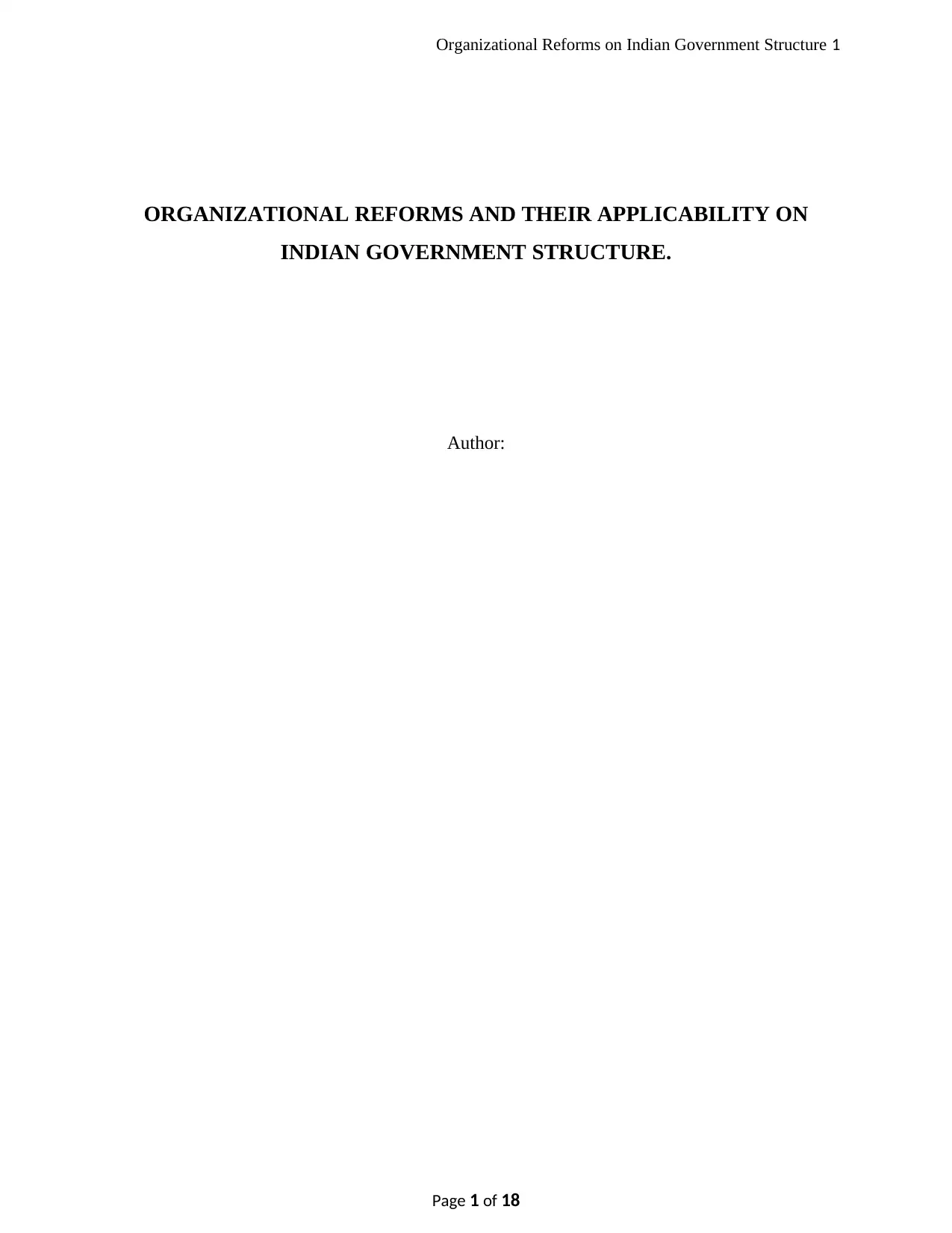
Organizational Reforms on Indian Government Structure 1
ORGANIZATIONAL REFORMS AND THEIR APPLICABILITY ON
INDIAN GOVERNMENT STRUCTURE.
Author:
Page 1 of 18
ORGANIZATIONAL REFORMS AND THEIR APPLICABILITY ON
INDIAN GOVERNMENT STRUCTURE.
Author:
Page 1 of 18
Paraphrase This Document
Need a fresh take? Get an instant paraphrase of this document with our AI Paraphraser
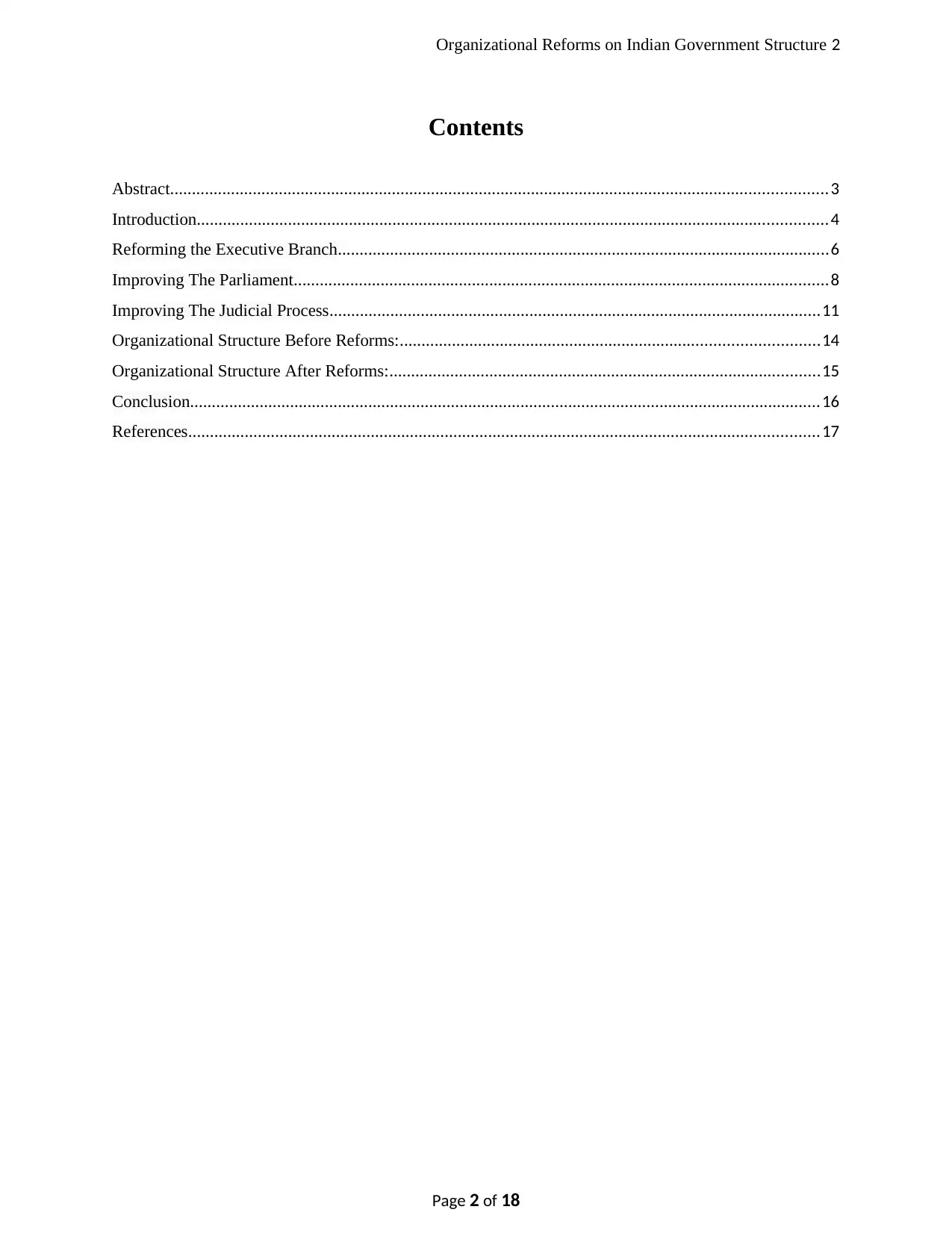
Organizational Reforms on Indian Government Structure 2
Contents
Abstract.......................................................................................................................................................3
Introduction.................................................................................................................................................4
Reforming the Executive Branch.................................................................................................................6
Improving The Parliament...........................................................................................................................8
Improving The Judicial Process.................................................................................................................11
Organizational Structure Before Reforms:................................................................................................14
Organizational Structure After Reforms:...................................................................................................15
Conclusion.................................................................................................................................................16
References.................................................................................................................................................17
Page 2 of 18
Contents
Abstract.......................................................................................................................................................3
Introduction.................................................................................................................................................4
Reforming the Executive Branch.................................................................................................................6
Improving The Parliament...........................................................................................................................8
Improving The Judicial Process.................................................................................................................11
Organizational Structure Before Reforms:................................................................................................14
Organizational Structure After Reforms:...................................................................................................15
Conclusion.................................................................................................................................................16
References.................................................................................................................................................17
Page 2 of 18
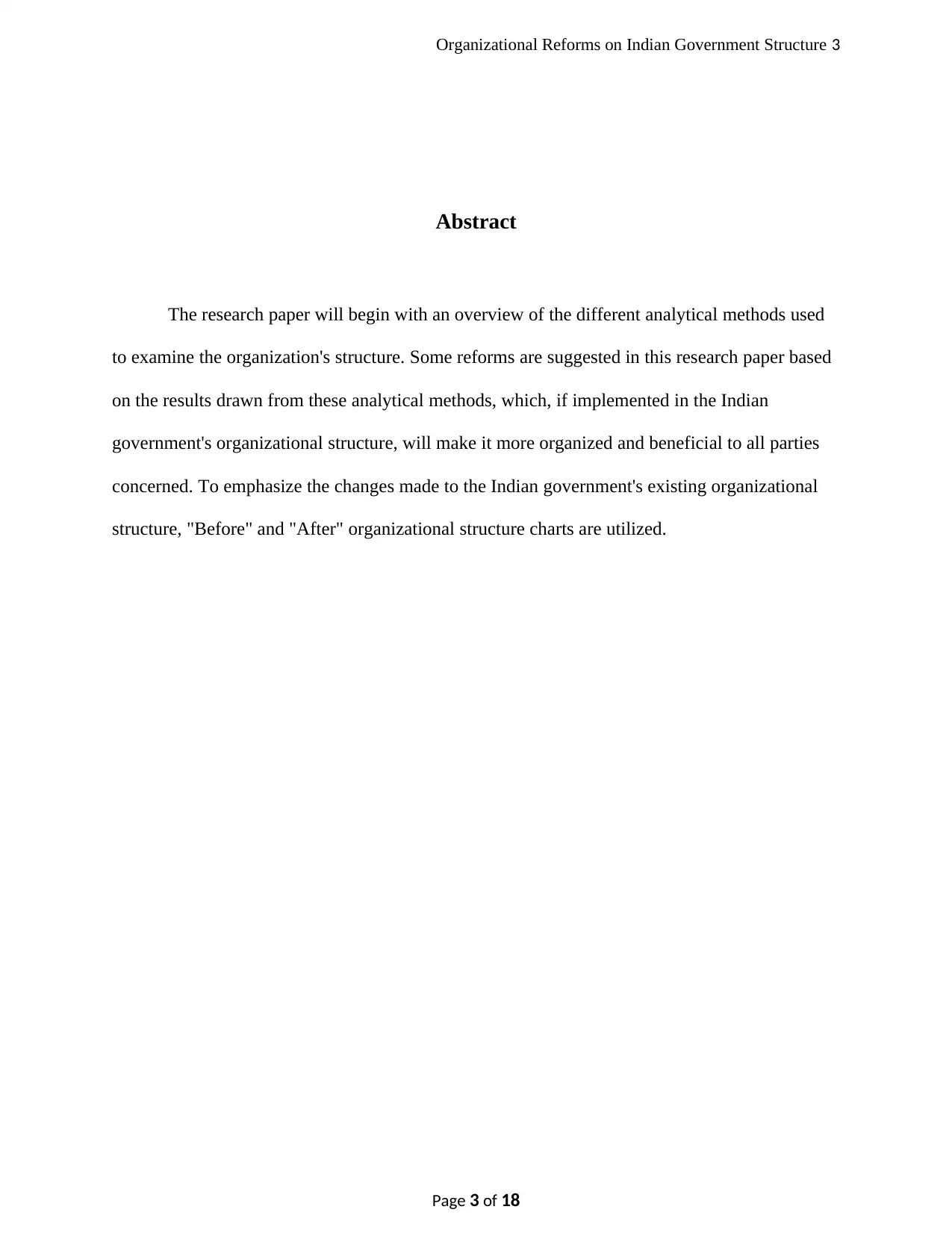
Organizational Reforms on Indian Government Structure 3
Abstract
The research paper will begin with an overview of the different analytical methods used
to examine the organization's structure. Some reforms are suggested in this research paper based
on the results drawn from these analytical methods, which, if implemented in the Indian
government's organizational structure, will make it more organized and beneficial to all parties
concerned. To emphasize the changes made to the Indian government's existing organizational
structure, "Before" and "After" organizational structure charts are utilized.
Page 3 of 18
Abstract
The research paper will begin with an overview of the different analytical methods used
to examine the organization's structure. Some reforms are suggested in this research paper based
on the results drawn from these analytical methods, which, if implemented in the Indian
government's organizational structure, will make it more organized and beneficial to all parties
concerned. To emphasize the changes made to the Indian government's existing organizational
structure, "Before" and "After" organizational structure charts are utilized.
Page 3 of 18
⊘ This is a preview!⊘
Do you want full access?
Subscribe today to unlock all pages.

Trusted by 1+ million students worldwide
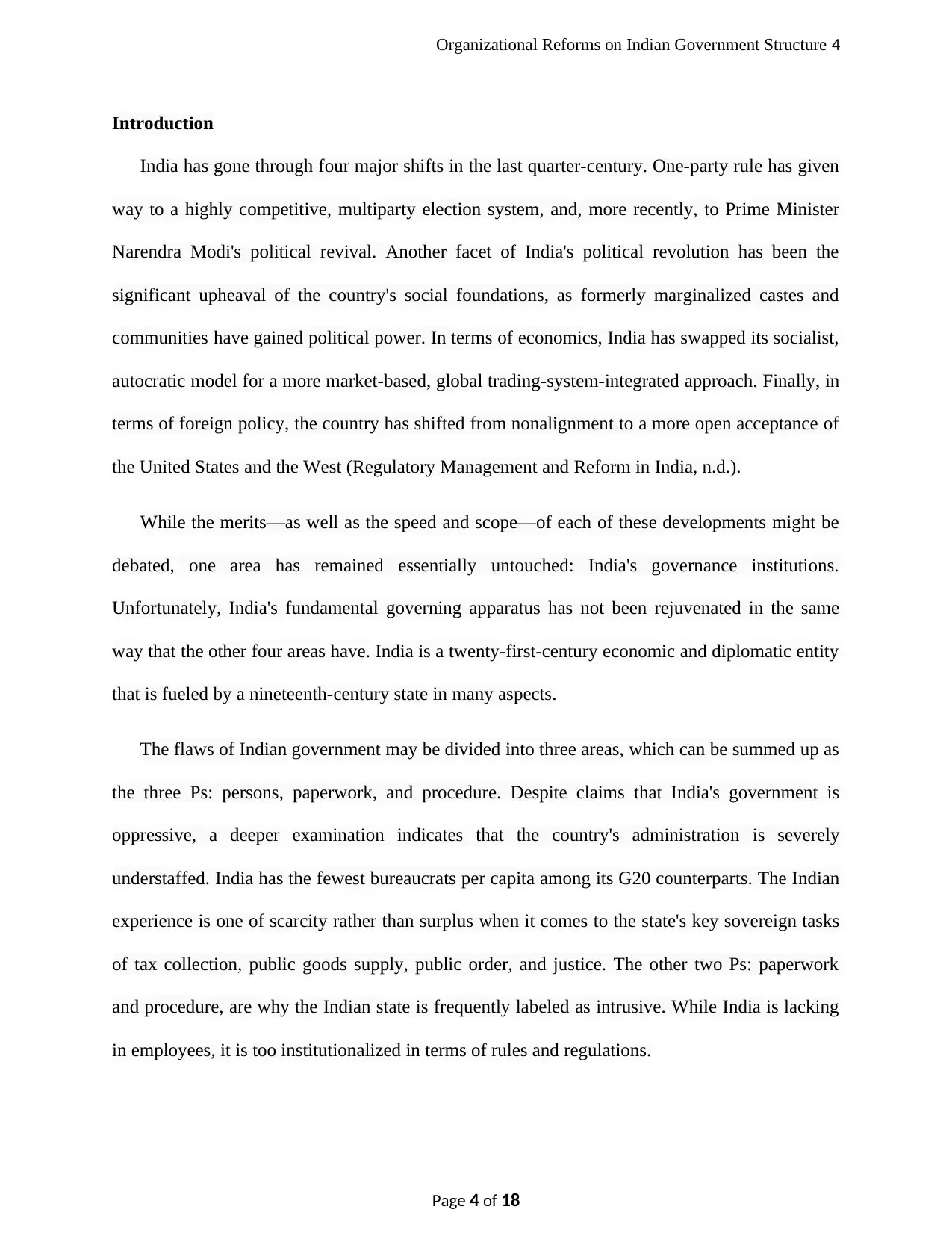
Organizational Reforms on Indian Government Structure 4
Introduction
India has gone through four major shifts in the last quarter-century. One-party rule has given
way to a highly competitive, multiparty election system, and, more recently, to Prime Minister
Narendra Modi's political revival. Another facet of India's political revolution has been the
significant upheaval of the country's social foundations, as formerly marginalized castes and
communities have gained political power. In terms of economics, India has swapped its socialist,
autocratic model for a more market-based, global trading-system-integrated approach. Finally, in
terms of foreign policy, the country has shifted from nonalignment to a more open acceptance of
the United States and the West (Regulatory Management and Reform in India, n.d.).
While the merits—as well as the speed and scope—of each of these developments might be
debated, one area has remained essentially untouched: India's governance institutions.
Unfortunately, India's fundamental governing apparatus has not been rejuvenated in the same
way that the other four areas have. India is a twenty-first-century economic and diplomatic entity
that is fueled by a nineteenth-century state in many aspects.
The flaws of Indian government may be divided into three areas, which can be summed up as
the three Ps: persons, paperwork, and procedure. Despite claims that India's government is
oppressive, a deeper examination indicates that the country's administration is severely
understaffed. India has the fewest bureaucrats per capita among its G20 counterparts. The Indian
experience is one of scarcity rather than surplus when it comes to the state's key sovereign tasks
of tax collection, public goods supply, public order, and justice. The other two Ps: paperwork
and procedure, are why the Indian state is frequently labeled as intrusive. While India is lacking
in employees, it is too institutionalized in terms of rules and regulations.
Page 4 of 18
Introduction
India has gone through four major shifts in the last quarter-century. One-party rule has given
way to a highly competitive, multiparty election system, and, more recently, to Prime Minister
Narendra Modi's political revival. Another facet of India's political revolution has been the
significant upheaval of the country's social foundations, as formerly marginalized castes and
communities have gained political power. In terms of economics, India has swapped its socialist,
autocratic model for a more market-based, global trading-system-integrated approach. Finally, in
terms of foreign policy, the country has shifted from nonalignment to a more open acceptance of
the United States and the West (Regulatory Management and Reform in India, n.d.).
While the merits—as well as the speed and scope—of each of these developments might be
debated, one area has remained essentially untouched: India's governance institutions.
Unfortunately, India's fundamental governing apparatus has not been rejuvenated in the same
way that the other four areas have. India is a twenty-first-century economic and diplomatic entity
that is fueled by a nineteenth-century state in many aspects.
The flaws of Indian government may be divided into three areas, which can be summed up as
the three Ps: persons, paperwork, and procedure. Despite claims that India's government is
oppressive, a deeper examination indicates that the country's administration is severely
understaffed. India has the fewest bureaucrats per capita among its G20 counterparts. The Indian
experience is one of scarcity rather than surplus when it comes to the state's key sovereign tasks
of tax collection, public goods supply, public order, and justice. The other two Ps: paperwork
and procedure, are why the Indian state is frequently labeled as intrusive. While India is lacking
in employees, it is too institutionalized in terms of rules and regulations.
Page 4 of 18
Paraphrase This Document
Need a fresh take? Get an instant paraphrase of this document with our AI Paraphraser
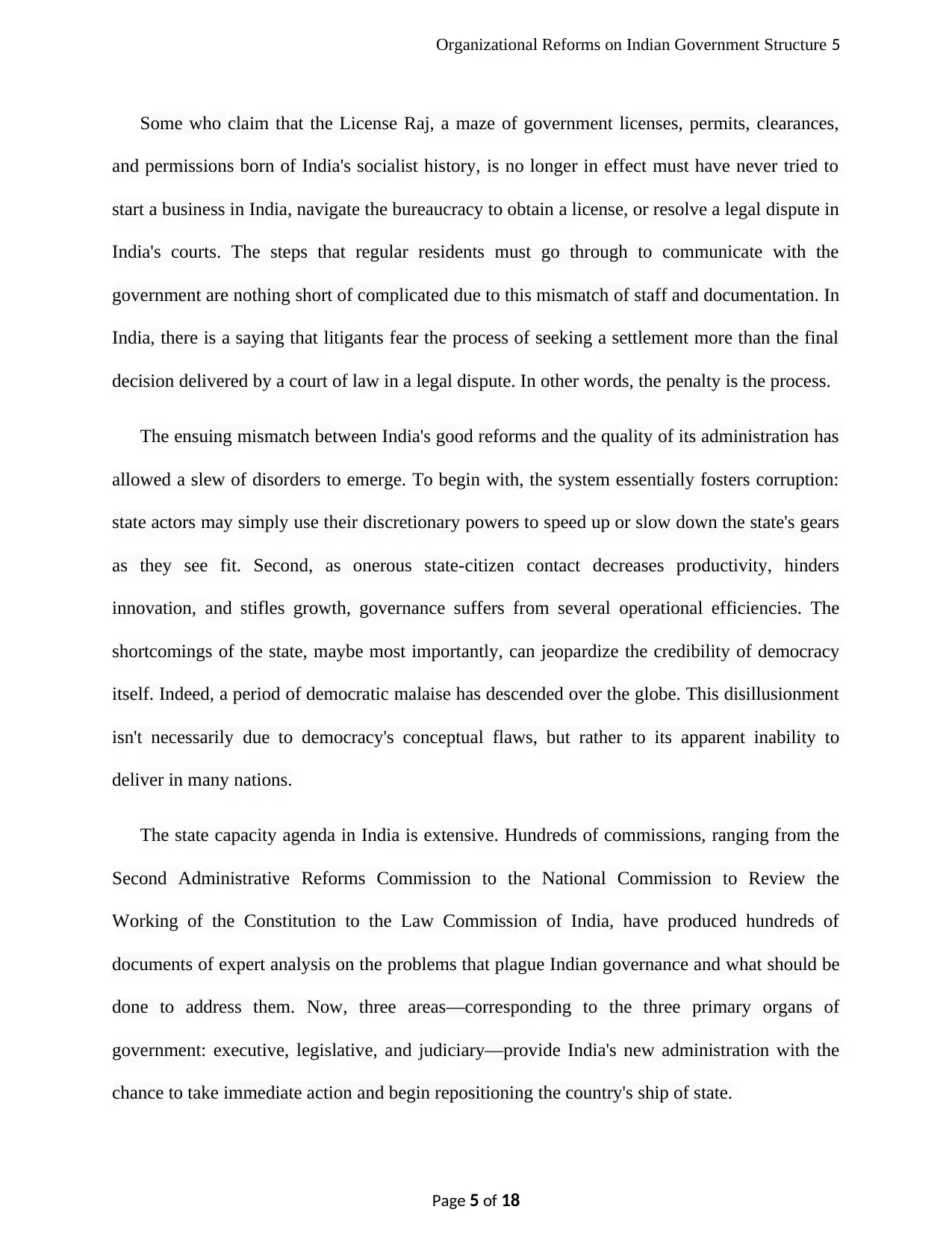
Organizational Reforms on Indian Government Structure 5
Some who claim that the License Raj, a maze of government licenses, permits, clearances,
and permissions born of India's socialist history, is no longer in effect must have never tried to
start a business in India, navigate the bureaucracy to obtain a license, or resolve a legal dispute in
India's courts. The steps that regular residents must go through to communicate with the
government are nothing short of complicated due to this mismatch of staff and documentation. In
India, there is a saying that litigants fear the process of seeking a settlement more than the final
decision delivered by a court of law in a legal dispute. In other words, the penalty is the process.
The ensuing mismatch between India's good reforms and the quality of its administration has
allowed a slew of disorders to emerge. To begin with, the system essentially fosters corruption:
state actors may simply use their discretionary powers to speed up or slow down the state's gears
as they see fit. Second, as onerous state-citizen contact decreases productivity, hinders
innovation, and stifles growth, governance suffers from several operational efficiencies. The
shortcomings of the state, maybe most importantly, can jeopardize the credibility of democracy
itself. Indeed, a period of democratic malaise has descended over the globe. This disillusionment
isn't necessarily due to democracy's conceptual flaws, but rather to its apparent inability to
deliver in many nations.
The state capacity agenda in India is extensive. Hundreds of commissions, ranging from the
Second Administrative Reforms Commission to the National Commission to Review the
Working of the Constitution to the Law Commission of India, have produced hundreds of
documents of expert analysis on the problems that plague Indian governance and what should be
done to address them. Now, three areas—corresponding to the three primary organs of
government: executive, legislative, and judiciary—provide India's new administration with the
chance to take immediate action and begin repositioning the country's ship of state.
Page 5 of 18
Some who claim that the License Raj, a maze of government licenses, permits, clearances,
and permissions born of India's socialist history, is no longer in effect must have never tried to
start a business in India, navigate the bureaucracy to obtain a license, or resolve a legal dispute in
India's courts. The steps that regular residents must go through to communicate with the
government are nothing short of complicated due to this mismatch of staff and documentation. In
India, there is a saying that litigants fear the process of seeking a settlement more than the final
decision delivered by a court of law in a legal dispute. In other words, the penalty is the process.
The ensuing mismatch between India's good reforms and the quality of its administration has
allowed a slew of disorders to emerge. To begin with, the system essentially fosters corruption:
state actors may simply use their discretionary powers to speed up or slow down the state's gears
as they see fit. Second, as onerous state-citizen contact decreases productivity, hinders
innovation, and stifles growth, governance suffers from several operational efficiencies. The
shortcomings of the state, maybe most importantly, can jeopardize the credibility of democracy
itself. Indeed, a period of democratic malaise has descended over the globe. This disillusionment
isn't necessarily due to democracy's conceptual flaws, but rather to its apparent inability to
deliver in many nations.
The state capacity agenda in India is extensive. Hundreds of commissions, ranging from the
Second Administrative Reforms Commission to the National Commission to Review the
Working of the Constitution to the Law Commission of India, have produced hundreds of
documents of expert analysis on the problems that plague Indian governance and what should be
done to address them. Now, three areas—corresponding to the three primary organs of
government: executive, legislative, and judiciary—provide India's new administration with the
chance to take immediate action and begin repositioning the country's ship of state.
Page 5 of 18
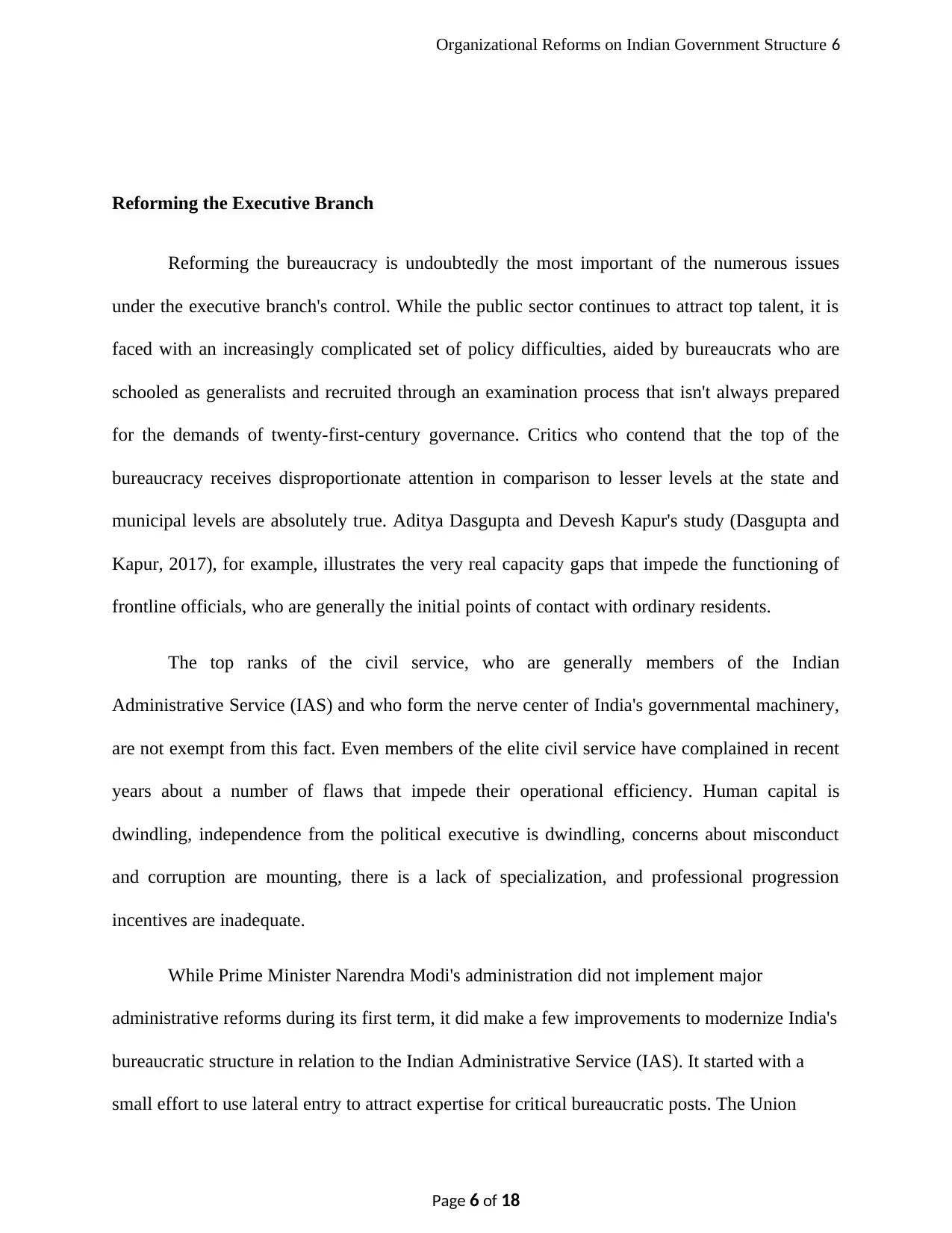
Organizational Reforms on Indian Government Structure 6
Reforming the Executive Branch
Reforming the bureaucracy is undoubtedly the most important of the numerous issues
under the executive branch's control. While the public sector continues to attract top talent, it is
faced with an increasingly complicated set of policy difficulties, aided by bureaucrats who are
schooled as generalists and recruited through an examination process that isn't always prepared
for the demands of twenty-first-century governance. Critics who contend that the top of the
bureaucracy receives disproportionate attention in comparison to lesser levels at the state and
municipal levels are absolutely true. Aditya Dasgupta and Devesh Kapur's study (Dasgupta and
Kapur, 2017), for example, illustrates the very real capacity gaps that impede the functioning of
frontline officials, who are generally the initial points of contact with ordinary residents.
The top ranks of the civil service, who are generally members of the Indian
Administrative Service (IAS) and who form the nerve center of India's governmental machinery,
are not exempt from this fact. Even members of the elite civil service have complained in recent
years about a number of flaws that impede their operational efficiency. Human capital is
dwindling, independence from the political executive is dwindling, concerns about misconduct
and corruption are mounting, there is a lack of specialization, and professional progression
incentives are inadequate.
While Prime Minister Narendra Modi's administration did not implement major
administrative reforms during its first term, it did make a few improvements to modernize India's
bureaucratic structure in relation to the Indian Administrative Service (IAS). It started with a
small effort to use lateral entry to attract expertise for critical bureaucratic posts. The Union
Page 6 of 18
Reforming the Executive Branch
Reforming the bureaucracy is undoubtedly the most important of the numerous issues
under the executive branch's control. While the public sector continues to attract top talent, it is
faced with an increasingly complicated set of policy difficulties, aided by bureaucrats who are
schooled as generalists and recruited through an examination process that isn't always prepared
for the demands of twenty-first-century governance. Critics who contend that the top of the
bureaucracy receives disproportionate attention in comparison to lesser levels at the state and
municipal levels are absolutely true. Aditya Dasgupta and Devesh Kapur's study (Dasgupta and
Kapur, 2017), for example, illustrates the very real capacity gaps that impede the functioning of
frontline officials, who are generally the initial points of contact with ordinary residents.
The top ranks of the civil service, who are generally members of the Indian
Administrative Service (IAS) and who form the nerve center of India's governmental machinery,
are not exempt from this fact. Even members of the elite civil service have complained in recent
years about a number of flaws that impede their operational efficiency. Human capital is
dwindling, independence from the political executive is dwindling, concerns about misconduct
and corruption are mounting, there is a lack of specialization, and professional progression
incentives are inadequate.
While Prime Minister Narendra Modi's administration did not implement major
administrative reforms during its first term, it did make a few improvements to modernize India's
bureaucratic structure in relation to the Indian Administrative Service (IAS). It started with a
small effort to use lateral entry to attract expertise for critical bureaucratic posts. The Union
Page 6 of 18
⊘ This is a preview!⊘
Do you want full access?
Subscribe today to unlock all pages.

Trusted by 1+ million students worldwide
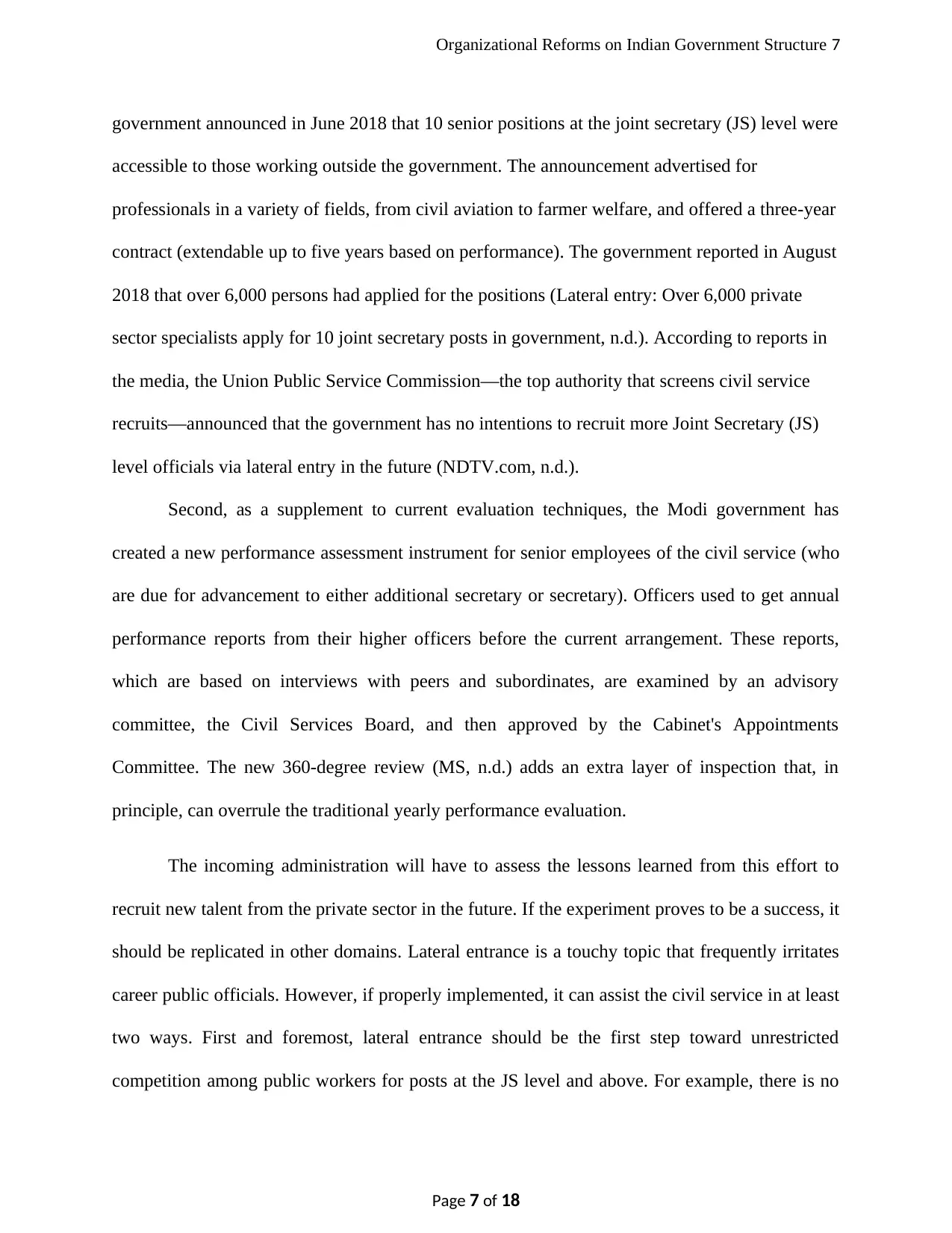
Organizational Reforms on Indian Government Structure 7
government announced in June 2018 that 10 senior positions at the joint secretary (JS) level were
accessible to those working outside the government. The announcement advertised for
professionals in a variety of fields, from civil aviation to farmer welfare, and offered a three-year
contract (extendable up to five years based on performance). The government reported in August
2018 that over 6,000 persons had applied for the positions (Lateral entry: Over 6,000 private
sector specialists apply for 10 joint secretary posts in government, n.d.). According to reports in
the media, the Union Public Service Commission—the top authority that screens civil service
recruits—announced that the government has no intentions to recruit more Joint Secretary (JS)
level officials via lateral entry in the future (NDTV.com, n.d.).
Second, as a supplement to current evaluation techniques, the Modi government has
created a new performance assessment instrument for senior employees of the civil service (who
are due for advancement to either additional secretary or secretary). Officers used to get annual
performance reports from their higher officers before the current arrangement. These reports,
which are based on interviews with peers and subordinates, are examined by an advisory
committee, the Civil Services Board, and then approved by the Cabinet's Appointments
Committee. The new 360-degree review (MS, n.d.) adds an extra layer of inspection that, in
principle, can overrule the traditional yearly performance evaluation.
The incoming administration will have to assess the lessons learned from this effort to
recruit new talent from the private sector in the future. If the experiment proves to be a success, it
should be replicated in other domains. Lateral entrance is a touchy topic that frequently irritates
career public officials. However, if properly implemented, it can assist the civil service in at least
two ways. First and foremost, lateral entrance should be the first step toward unrestricted
competition among public workers for posts at the JS level and above. For example, there is no
Page 7 of 18
government announced in June 2018 that 10 senior positions at the joint secretary (JS) level were
accessible to those working outside the government. The announcement advertised for
professionals in a variety of fields, from civil aviation to farmer welfare, and offered a three-year
contract (extendable up to five years based on performance). The government reported in August
2018 that over 6,000 persons had applied for the positions (Lateral entry: Over 6,000 private
sector specialists apply for 10 joint secretary posts in government, n.d.). According to reports in
the media, the Union Public Service Commission—the top authority that screens civil service
recruits—announced that the government has no intentions to recruit more Joint Secretary (JS)
level officials via lateral entry in the future (NDTV.com, n.d.).
Second, as a supplement to current evaluation techniques, the Modi government has
created a new performance assessment instrument for senior employees of the civil service (who
are due for advancement to either additional secretary or secretary). Officers used to get annual
performance reports from their higher officers before the current arrangement. These reports,
which are based on interviews with peers and subordinates, are examined by an advisory
committee, the Civil Services Board, and then approved by the Cabinet's Appointments
Committee. The new 360-degree review (MS, n.d.) adds an extra layer of inspection that, in
principle, can overrule the traditional yearly performance evaluation.
The incoming administration will have to assess the lessons learned from this effort to
recruit new talent from the private sector in the future. If the experiment proves to be a success, it
should be replicated in other domains. Lateral entrance is a touchy topic that frequently irritates
career public officials. However, if properly implemented, it can assist the civil service in at least
two ways. First and foremost, lateral entrance should be the first step toward unrestricted
competition among public workers for posts at the JS level and above. For example, there is no
Page 7 of 18
Paraphrase This Document
Need a fresh take? Get an instant paraphrase of this document with our AI Paraphraser
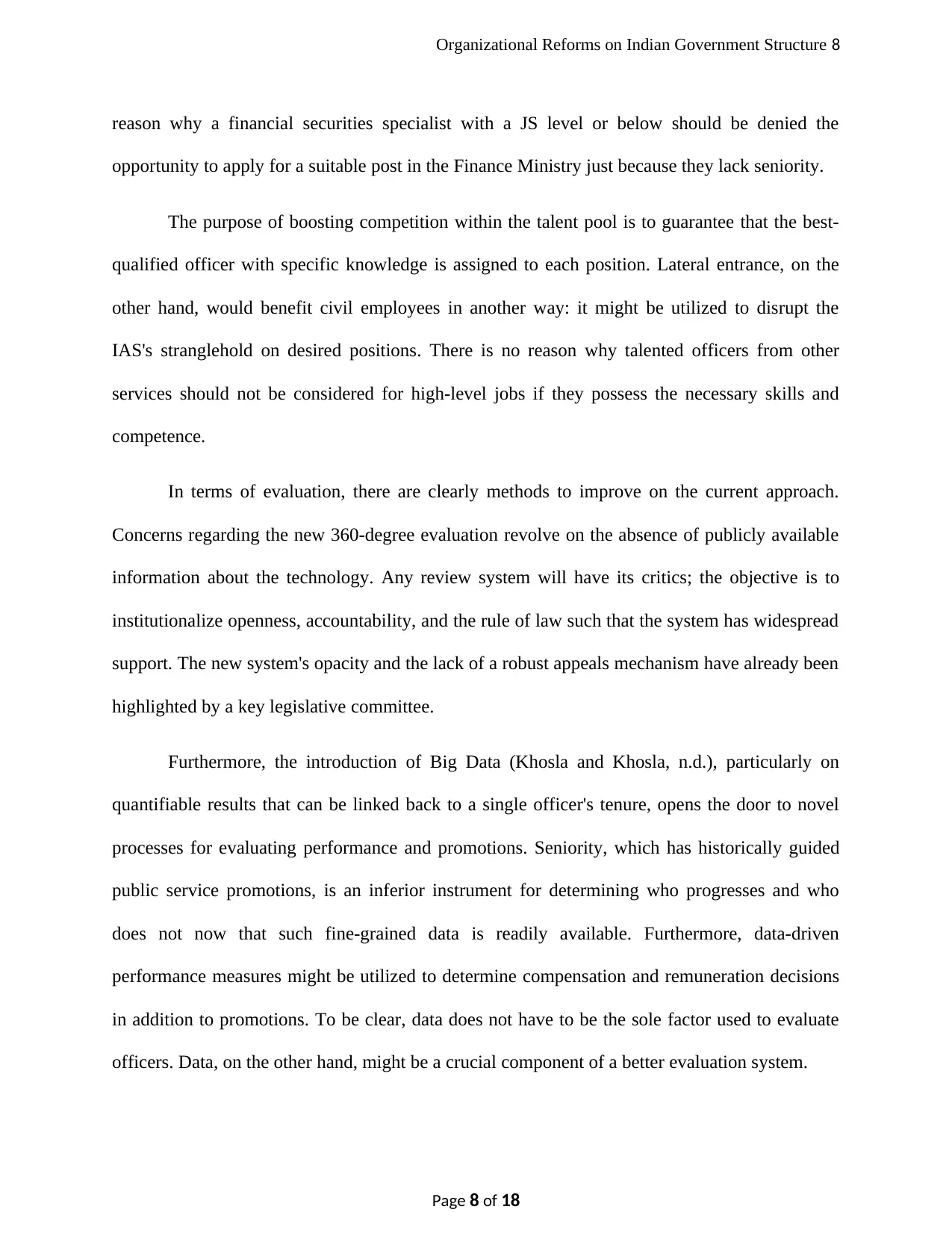
Organizational Reforms on Indian Government Structure 8
reason why a financial securities specialist with a JS level or below should be denied the
opportunity to apply for a suitable post in the Finance Ministry just because they lack seniority.
The purpose of boosting competition within the talent pool is to guarantee that the best-
qualified officer with specific knowledge is assigned to each position. Lateral entrance, on the
other hand, would benefit civil employees in another way: it might be utilized to disrupt the
IAS's stranglehold on desired positions. There is no reason why talented officers from other
services should not be considered for high-level jobs if they possess the necessary skills and
competence.
In terms of evaluation, there are clearly methods to improve on the current approach.
Concerns regarding the new 360-degree evaluation revolve on the absence of publicly available
information about the technology. Any review system will have its critics; the objective is to
institutionalize openness, accountability, and the rule of law such that the system has widespread
support. The new system's opacity and the lack of a robust appeals mechanism have already been
highlighted by a key legislative committee.
Furthermore, the introduction of Big Data (Khosla and Khosla, n.d.), particularly on
quantifiable results that can be linked back to a single officer's tenure, opens the door to novel
processes for evaluating performance and promotions. Seniority, which has historically guided
public service promotions, is an inferior instrument for determining who progresses and who
does not now that such fine-grained data is readily available. Furthermore, data-driven
performance measures might be utilized to determine compensation and remuneration decisions
in addition to promotions. To be clear, data does not have to be the sole factor used to evaluate
officers. Data, on the other hand, might be a crucial component of a better evaluation system.
Page 8 of 18
reason why a financial securities specialist with a JS level or below should be denied the
opportunity to apply for a suitable post in the Finance Ministry just because they lack seniority.
The purpose of boosting competition within the talent pool is to guarantee that the best-
qualified officer with specific knowledge is assigned to each position. Lateral entrance, on the
other hand, would benefit civil employees in another way: it might be utilized to disrupt the
IAS's stranglehold on desired positions. There is no reason why talented officers from other
services should not be considered for high-level jobs if they possess the necessary skills and
competence.
In terms of evaluation, there are clearly methods to improve on the current approach.
Concerns regarding the new 360-degree evaluation revolve on the absence of publicly available
information about the technology. Any review system will have its critics; the objective is to
institutionalize openness, accountability, and the rule of law such that the system has widespread
support. The new system's opacity and the lack of a robust appeals mechanism have already been
highlighted by a key legislative committee.
Furthermore, the introduction of Big Data (Khosla and Khosla, n.d.), particularly on
quantifiable results that can be linked back to a single officer's tenure, opens the door to novel
processes for evaluating performance and promotions. Seniority, which has historically guided
public service promotions, is an inferior instrument for determining who progresses and who
does not now that such fine-grained data is readily available. Furthermore, data-driven
performance measures might be utilized to determine compensation and remuneration decisions
in addition to promotions. To be clear, data does not have to be the sole factor used to evaluate
officers. Data, on the other hand, might be a crucial component of a better evaluation system.
Page 8 of 18
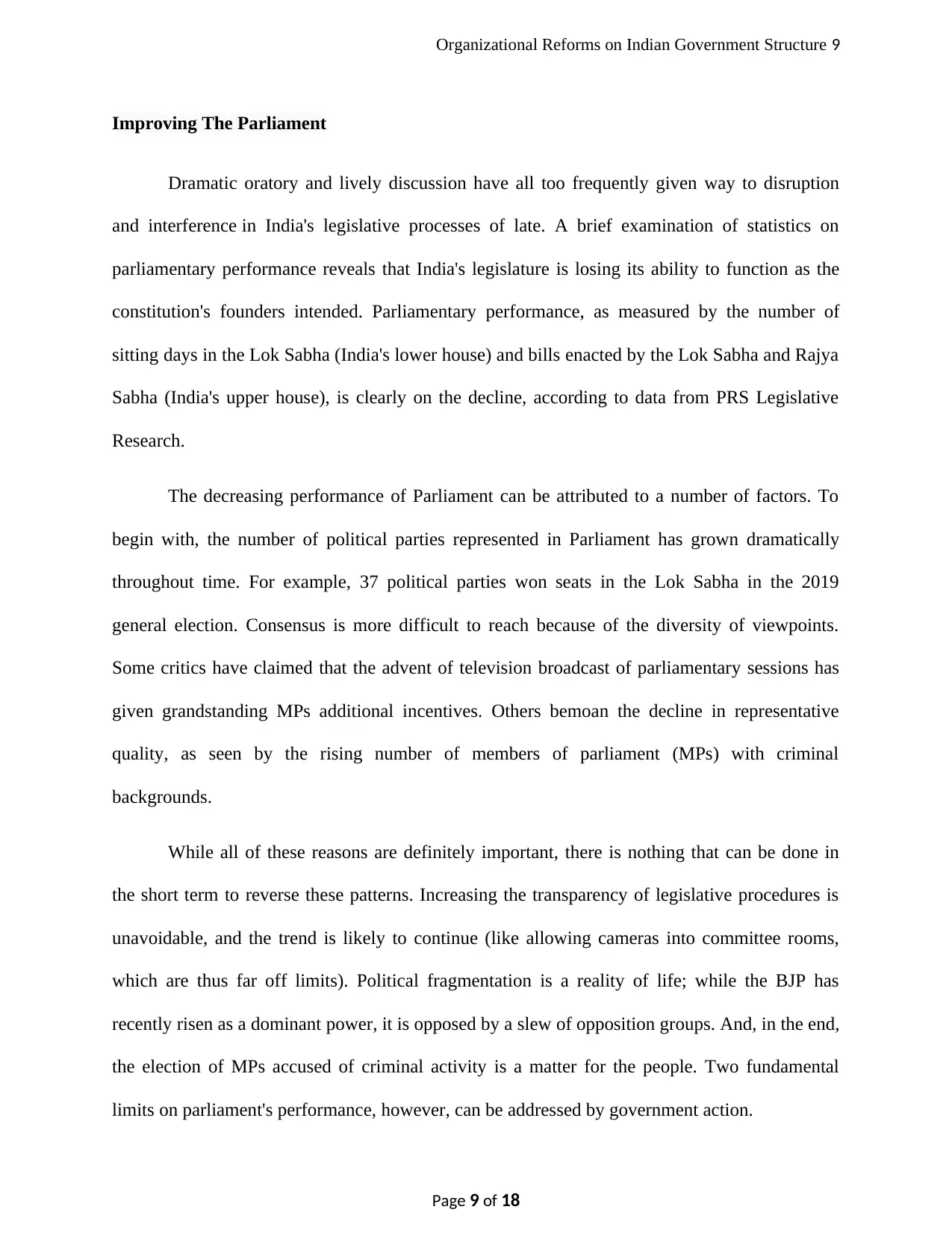
Organizational Reforms on Indian Government Structure 9
Improving The Parliament
Dramatic oratory and lively discussion have all too frequently given way to disruption
and interference in India's legislative processes of late. A brief examination of statistics on
parliamentary performance reveals that India's legislature is losing its ability to function as the
constitution's founders intended. Parliamentary performance, as measured by the number of
sitting days in the Lok Sabha (India's lower house) and bills enacted by the Lok Sabha and Rajya
Sabha (India's upper house), is clearly on the decline, according to data from PRS Legislative
Research.
The decreasing performance of Parliament can be attributed to a number of factors. To
begin with, the number of political parties represented in Parliament has grown dramatically
throughout time. For example, 37 political parties won seats in the Lok Sabha in the 2019
general election. Consensus is more difficult to reach because of the diversity of viewpoints.
Some critics have claimed that the advent of television broadcast of parliamentary sessions has
given grandstanding MPs additional incentives. Others bemoan the decline in representative
quality, as seen by the rising number of members of parliament (MPs) with criminal
backgrounds.
While all of these reasons are definitely important, there is nothing that can be done in
the short term to reverse these patterns. Increasing the transparency of legislative procedures is
unavoidable, and the trend is likely to continue (like allowing cameras into committee rooms,
which are thus far off limits). Political fragmentation is a reality of life; while the BJP has
recently risen as a dominant power, it is opposed by a slew of opposition groups. And, in the end,
the election of MPs accused of criminal activity is a matter for the people. Two fundamental
limits on parliament's performance, however, can be addressed by government action.
Page 9 of 18
Improving The Parliament
Dramatic oratory and lively discussion have all too frequently given way to disruption
and interference in India's legislative processes of late. A brief examination of statistics on
parliamentary performance reveals that India's legislature is losing its ability to function as the
constitution's founders intended. Parliamentary performance, as measured by the number of
sitting days in the Lok Sabha (India's lower house) and bills enacted by the Lok Sabha and Rajya
Sabha (India's upper house), is clearly on the decline, according to data from PRS Legislative
Research.
The decreasing performance of Parliament can be attributed to a number of factors. To
begin with, the number of political parties represented in Parliament has grown dramatically
throughout time. For example, 37 political parties won seats in the Lok Sabha in the 2019
general election. Consensus is more difficult to reach because of the diversity of viewpoints.
Some critics have claimed that the advent of television broadcast of parliamentary sessions has
given grandstanding MPs additional incentives. Others bemoan the decline in representative
quality, as seen by the rising number of members of parliament (MPs) with criminal
backgrounds.
While all of these reasons are definitely important, there is nothing that can be done in
the short term to reverse these patterns. Increasing the transparency of legislative procedures is
unavoidable, and the trend is likely to continue (like allowing cameras into committee rooms,
which are thus far off limits). Political fragmentation is a reality of life; while the BJP has
recently risen as a dominant power, it is opposed by a slew of opposition groups. And, in the end,
the election of MPs accused of criminal activity is a matter for the people. Two fundamental
limits on parliament's performance, however, can be addressed by government action.
Page 9 of 18
⊘ This is a preview!⊘
Do you want full access?
Subscribe today to unlock all pages.

Trusted by 1+ million students worldwide
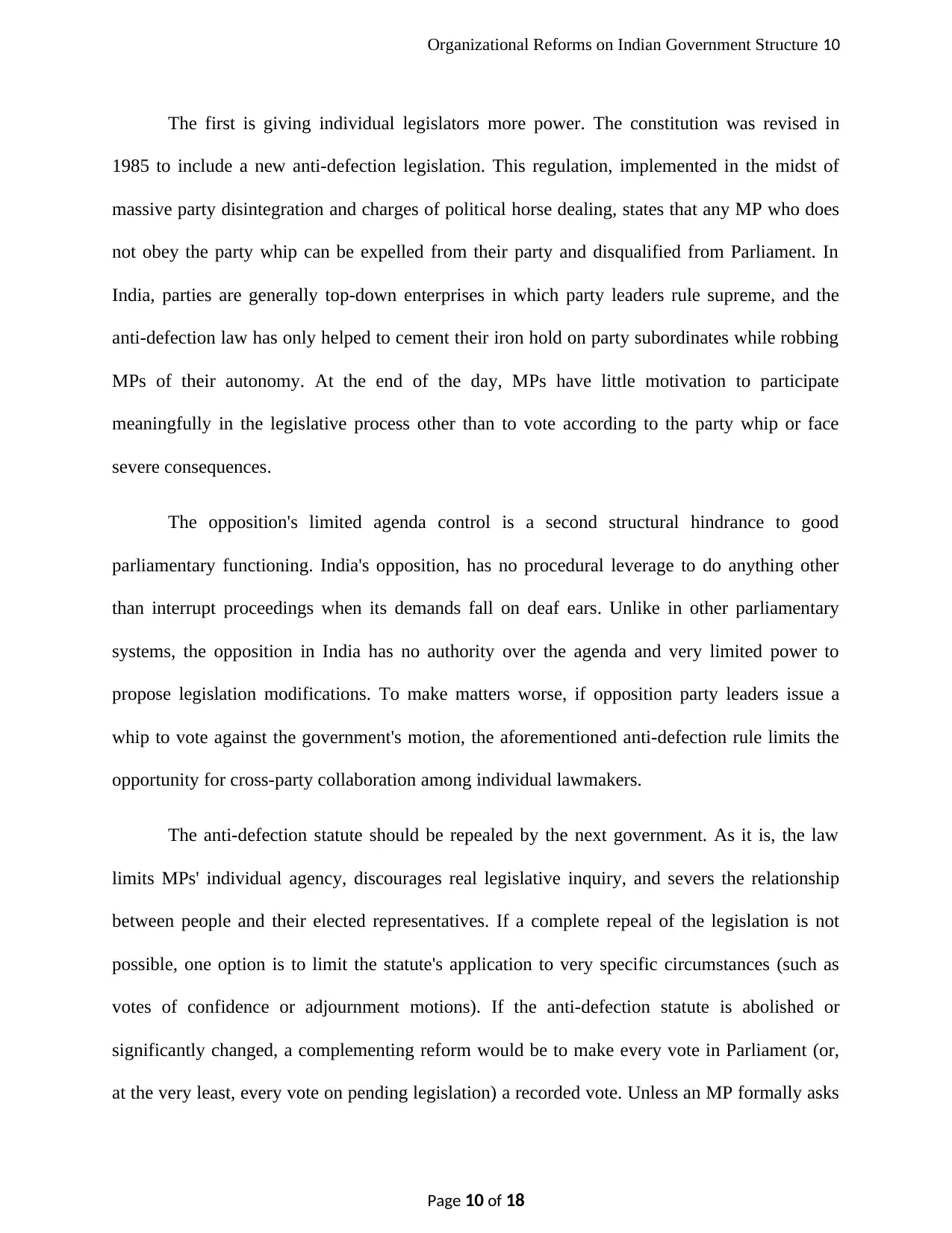
Organizational Reforms on Indian Government Structure 10
The first is giving individual legislators more power. The constitution was revised in
1985 to include a new anti-defection legislation. This regulation, implemented in the midst of
massive party disintegration and charges of political horse dealing, states that any MP who does
not obey the party whip can be expelled from their party and disqualified from Parliament. In
India, parties are generally top-down enterprises in which party leaders rule supreme, and the
anti-defection law has only helped to cement their iron hold on party subordinates while robbing
MPs of their autonomy. At the end of the day, MPs have little motivation to participate
meaningfully in the legislative process other than to vote according to the party whip or face
severe consequences.
The opposition's limited agenda control is a second structural hindrance to good
parliamentary functioning. India's opposition, has no procedural leverage to do anything other
than interrupt proceedings when its demands fall on deaf ears. Unlike in other parliamentary
systems, the opposition in India has no authority over the agenda and very limited power to
propose legislation modifications. To make matters worse, if opposition party leaders issue a
whip to vote against the government's motion, the aforementioned anti-defection rule limits the
opportunity for cross-party collaboration among individual lawmakers.
The anti-defection statute should be repealed by the next government. As it is, the law
limits MPs' individual agency, discourages real legislative inquiry, and severs the relationship
between people and their elected representatives. If a complete repeal of the legislation is not
possible, one option is to limit the statute's application to very specific circumstances (such as
votes of confidence or adjournment motions). If the anti-defection statute is abolished or
significantly changed, a complementing reform would be to make every vote in Parliament (or,
at the very least, every vote on pending legislation) a recorded vote. Unless an MP formally asks
Page 10 of 18
The first is giving individual legislators more power. The constitution was revised in
1985 to include a new anti-defection legislation. This regulation, implemented in the midst of
massive party disintegration and charges of political horse dealing, states that any MP who does
not obey the party whip can be expelled from their party and disqualified from Parliament. In
India, parties are generally top-down enterprises in which party leaders rule supreme, and the
anti-defection law has only helped to cement their iron hold on party subordinates while robbing
MPs of their autonomy. At the end of the day, MPs have little motivation to participate
meaningfully in the legislative process other than to vote according to the party whip or face
severe consequences.
The opposition's limited agenda control is a second structural hindrance to good
parliamentary functioning. India's opposition, has no procedural leverage to do anything other
than interrupt proceedings when its demands fall on deaf ears. Unlike in other parliamentary
systems, the opposition in India has no authority over the agenda and very limited power to
propose legislation modifications. To make matters worse, if opposition party leaders issue a
whip to vote against the government's motion, the aforementioned anti-defection rule limits the
opportunity for cross-party collaboration among individual lawmakers.
The anti-defection statute should be repealed by the next government. As it is, the law
limits MPs' individual agency, discourages real legislative inquiry, and severs the relationship
between people and their elected representatives. If a complete repeal of the legislation is not
possible, one option is to limit the statute's application to very specific circumstances (such as
votes of confidence or adjournment motions). If the anti-defection statute is abolished or
significantly changed, a complementing reform would be to make every vote in Parliament (or,
at the very least, every vote on pending legislation) a recorded vote. Unless an MP formally asks
Page 10 of 18
Paraphrase This Document
Need a fresh take? Get an instant paraphrase of this document with our AI Paraphraser
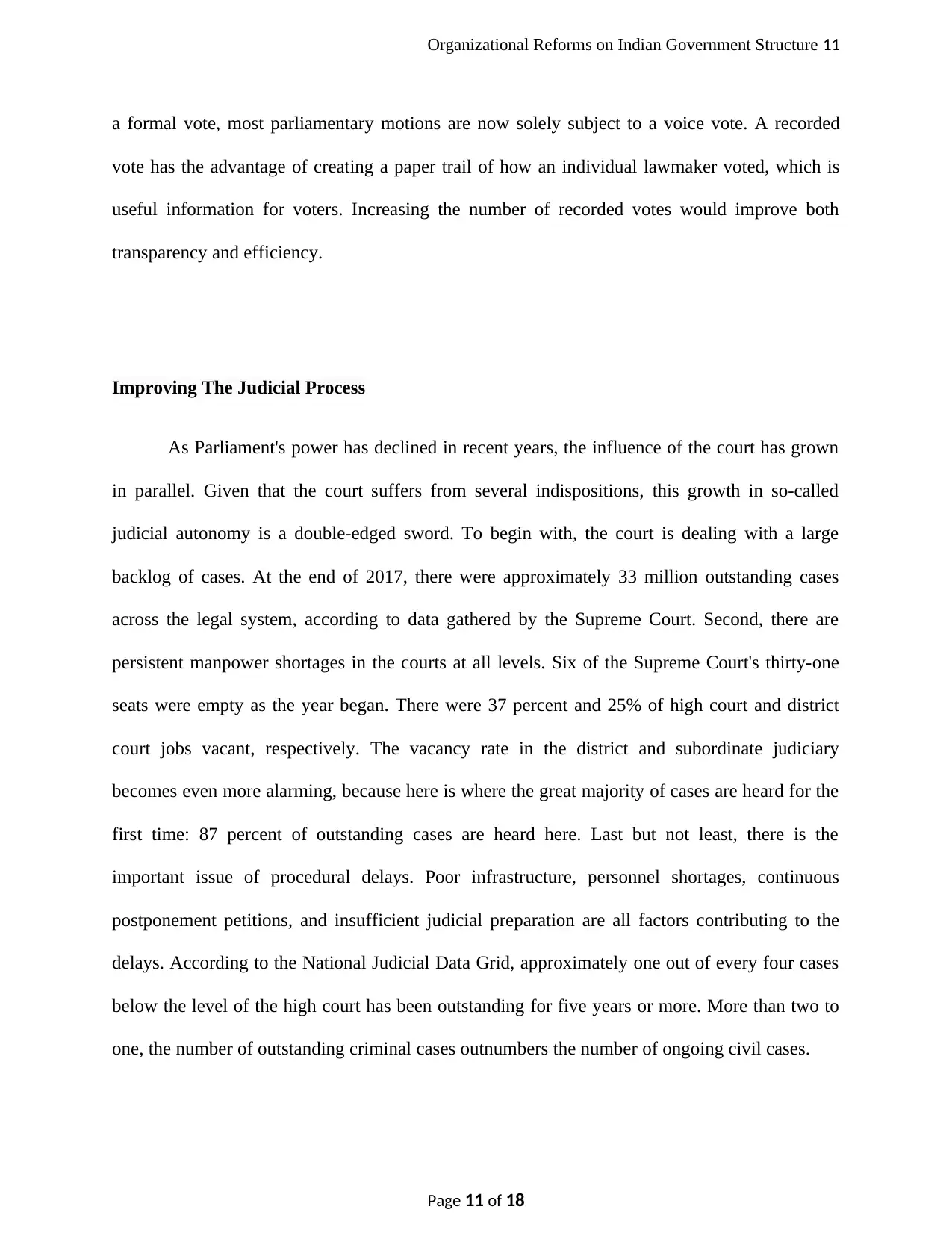
Organizational Reforms on Indian Government Structure 11
a formal vote, most parliamentary motions are now solely subject to a voice vote. A recorded
vote has the advantage of creating a paper trail of how an individual lawmaker voted, which is
useful information for voters. Increasing the number of recorded votes would improve both
transparency and efficiency.
Improving The Judicial Process
As Parliament's power has declined in recent years, the influence of the court has grown
in parallel. Given that the court suffers from several indispositions, this growth in so-called
judicial autonomy is a double-edged sword. To begin with, the court is dealing with a large
backlog of cases. At the end of 2017, there were approximately 33 million outstanding cases
across the legal system, according to data gathered by the Supreme Court. Second, there are
persistent manpower shortages in the courts at all levels. Six of the Supreme Court's thirty-one
seats were empty as the year began. There were 37 percent and 25% of high court and district
court jobs vacant, respectively. The vacancy rate in the district and subordinate judiciary
becomes even more alarming, because here is where the great majority of cases are heard for the
first time: 87 percent of outstanding cases are heard here. Last but not least, there is the
important issue of procedural delays. Poor infrastructure, personnel shortages, continuous
postponement petitions, and insufficient judicial preparation are all factors contributing to the
delays. According to the National Judicial Data Grid, approximately one out of every four cases
below the level of the high court has been outstanding for five years or more. More than two to
one, the number of outstanding criminal cases outnumbers the number of ongoing civil cases.
Page 11 of 18
a formal vote, most parliamentary motions are now solely subject to a voice vote. A recorded
vote has the advantage of creating a paper trail of how an individual lawmaker voted, which is
useful information for voters. Increasing the number of recorded votes would improve both
transparency and efficiency.
Improving The Judicial Process
As Parliament's power has declined in recent years, the influence of the court has grown
in parallel. Given that the court suffers from several indispositions, this growth in so-called
judicial autonomy is a double-edged sword. To begin with, the court is dealing with a large
backlog of cases. At the end of 2017, there were approximately 33 million outstanding cases
across the legal system, according to data gathered by the Supreme Court. Second, there are
persistent manpower shortages in the courts at all levels. Six of the Supreme Court's thirty-one
seats were empty as the year began. There were 37 percent and 25% of high court and district
court jobs vacant, respectively. The vacancy rate in the district and subordinate judiciary
becomes even more alarming, because here is where the great majority of cases are heard for the
first time: 87 percent of outstanding cases are heard here. Last but not least, there is the
important issue of procedural delays. Poor infrastructure, personnel shortages, continuous
postponement petitions, and insufficient judicial preparation are all factors contributing to the
delays. According to the National Judicial Data Grid, approximately one out of every four cases
below the level of the high court has been outstanding for five years or more. More than two to
one, the number of outstanding criminal cases outnumbers the number of ongoing civil cases.
Page 11 of 18
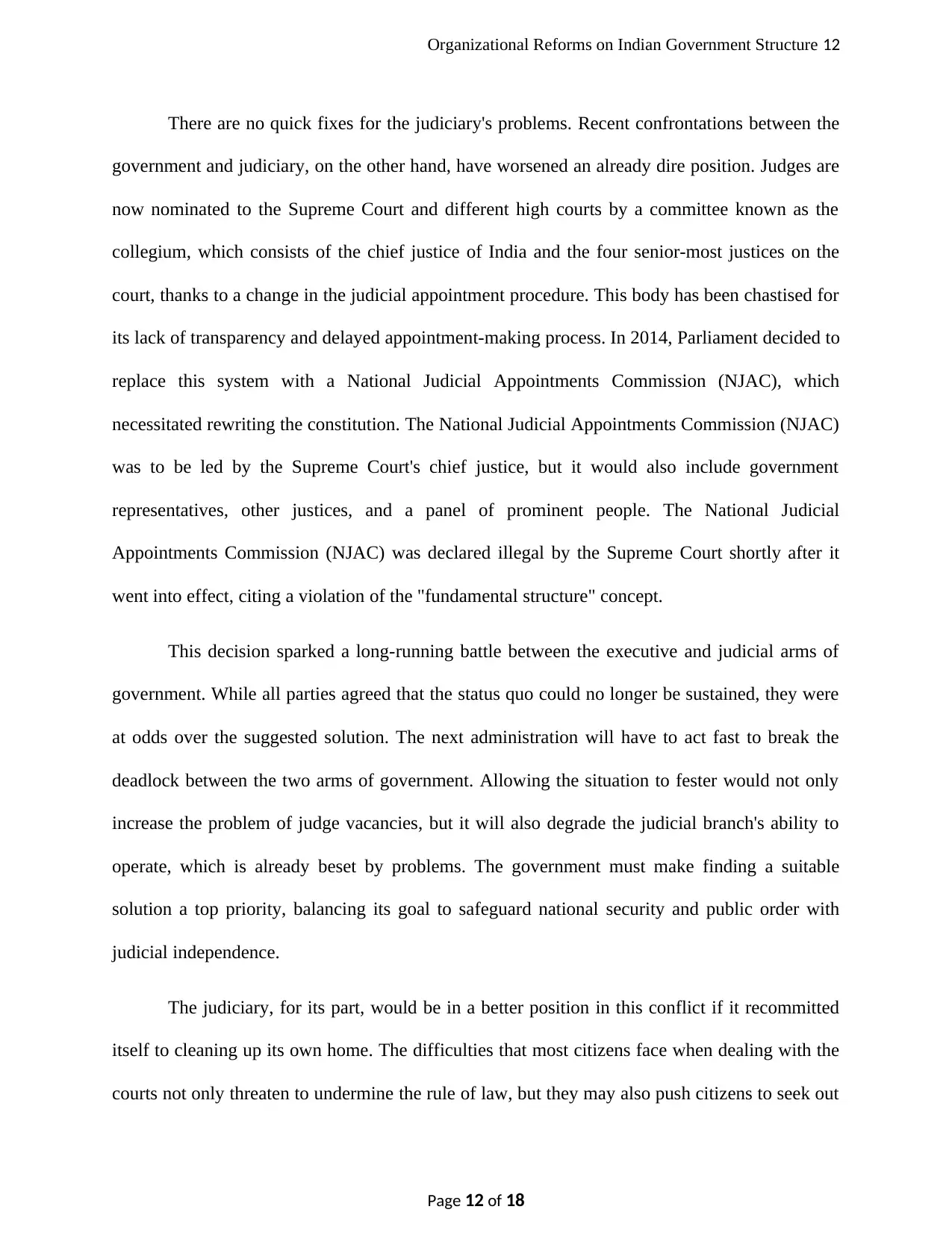
Organizational Reforms on Indian Government Structure 12
There are no quick fixes for the judiciary's problems. Recent confrontations between the
government and judiciary, on the other hand, have worsened an already dire position. Judges are
now nominated to the Supreme Court and different high courts by a committee known as the
collegium, which consists of the chief justice of India and the four senior-most justices on the
court, thanks to a change in the judicial appointment procedure. This body has been chastised for
its lack of transparency and delayed appointment-making process. In 2014, Parliament decided to
replace this system with a National Judicial Appointments Commission (NJAC), which
necessitated rewriting the constitution. The National Judicial Appointments Commission (NJAC)
was to be led by the Supreme Court's chief justice, but it would also include government
representatives, other justices, and a panel of prominent people. The National Judicial
Appointments Commission (NJAC) was declared illegal by the Supreme Court shortly after it
went into effect, citing a violation of the "fundamental structure" concept.
This decision sparked a long-running battle between the executive and judicial arms of
government. While all parties agreed that the status quo could no longer be sustained, they were
at odds over the suggested solution. The next administration will have to act fast to break the
deadlock between the two arms of government. Allowing the situation to fester would not only
increase the problem of judge vacancies, but it will also degrade the judicial branch's ability to
operate, which is already beset by problems. The government must make finding a suitable
solution a top priority, balancing its goal to safeguard national security and public order with
judicial independence.
The judiciary, for its part, would be in a better position in this conflict if it recommitted
itself to cleaning up its own home. The difficulties that most citizens face when dealing with the
courts not only threaten to undermine the rule of law, but they may also push citizens to seek out
Page 12 of 18
There are no quick fixes for the judiciary's problems. Recent confrontations between the
government and judiciary, on the other hand, have worsened an already dire position. Judges are
now nominated to the Supreme Court and different high courts by a committee known as the
collegium, which consists of the chief justice of India and the four senior-most justices on the
court, thanks to a change in the judicial appointment procedure. This body has been chastised for
its lack of transparency and delayed appointment-making process. In 2014, Parliament decided to
replace this system with a National Judicial Appointments Commission (NJAC), which
necessitated rewriting the constitution. The National Judicial Appointments Commission (NJAC)
was to be led by the Supreme Court's chief justice, but it would also include government
representatives, other justices, and a panel of prominent people. The National Judicial
Appointments Commission (NJAC) was declared illegal by the Supreme Court shortly after it
went into effect, citing a violation of the "fundamental structure" concept.
This decision sparked a long-running battle between the executive and judicial arms of
government. While all parties agreed that the status quo could no longer be sustained, they were
at odds over the suggested solution. The next administration will have to act fast to break the
deadlock between the two arms of government. Allowing the situation to fester would not only
increase the problem of judge vacancies, but it will also degrade the judicial branch's ability to
operate, which is already beset by problems. The government must make finding a suitable
solution a top priority, balancing its goal to safeguard national security and public order with
judicial independence.
The judiciary, for its part, would be in a better position in this conflict if it recommitted
itself to cleaning up its own home. The difficulties that most citizens face when dealing with the
courts not only threaten to undermine the rule of law, but they may also push citizens to seek out
Page 12 of 18
⊘ This is a preview!⊘
Do you want full access?
Subscribe today to unlock all pages.

Trusted by 1+ million students worldwide
1 out of 18
Related Documents
Your All-in-One AI-Powered Toolkit for Academic Success.
+13062052269
info@desklib.com
Available 24*7 on WhatsApp / Email
![[object Object]](/_next/static/media/star-bottom.7253800d.svg)
Unlock your academic potential
Copyright © 2020–2025 A2Z Services. All Rights Reserved. Developed and managed by ZUCOL.





